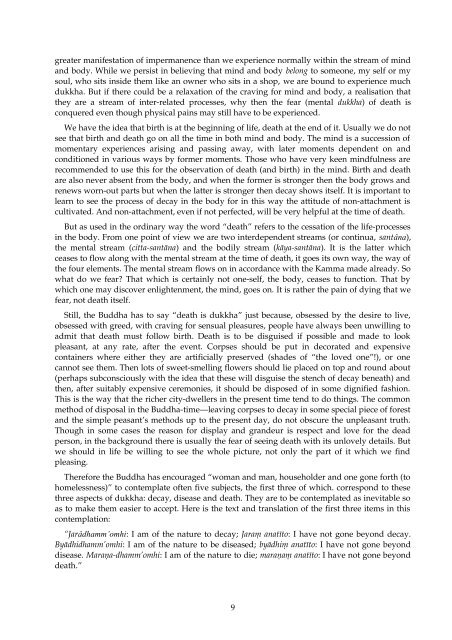The Three Basic Facts of Existence II: Suffering (Dukkha) - Buddhist ...
The Three Basic Facts of Existence II: Suffering (Dukkha) - Buddhist ...
The Three Basic Facts of Existence II: Suffering (Dukkha) - Buddhist ...
- No tags were found...
You also want an ePaper? Increase the reach of your titles
YUMPU automatically turns print PDFs into web optimized ePapers that Google loves.
greater manifestation <strong>of</strong> impermanence than we experience normally within the stream <strong>of</strong> mindand body. While we persist in believing that mind and body belong to someone, my self or mysoul, who sits inside them like an owner who sits in a shop, we are bound to experience muchdukkha. But if there could be a relaxation <strong>of</strong> the craving for mind and body, a realisation thatthey are a stream <strong>of</strong> inter-related processes, why then the fear (mental dukkha) <strong>of</strong> death isconquered even though physical pains may still have to be experienced.We have the idea that birth is at the beginning <strong>of</strong> life, death at the end <strong>of</strong> it. Usually we do notsee that birth and death go on all the time in both mind and body. <strong>The</strong> mind is a succession <strong>of</strong>momentary experiences arising and passing away, with later moments dependent on andconditioned in various ways by former moments. Those who have very keen mindfulness arerecommended to use this for the observation <strong>of</strong> death (and birth) in the mind. Birth and deathare also never absent from the body, and when the former is stronger then the body grows andrenews worn-out parts but when the latter is stronger then decay shows itself. It is important tolearn to see the process <strong>of</strong> decay in the body for in this way the attitude <strong>of</strong> non-attachment iscultivated. And non-attachment, even if not perfected, will be very helpful at the time <strong>of</strong> death.But as used in the ordinary way the word “death” refers to the cessation <strong>of</strong> the life-processesin the body. From one point <strong>of</strong> view we are two interdependent streams (or continua, santâna),the mental stream (citta-santāna) and the bodily stream (kāya-santāna). It is the latter whichceases to flow along with the mental stream at the time <strong>of</strong> death, it goes its own way, the way <strong>of</strong>the four elements. <strong>The</strong> mental stream flows on in accordance with the Kamma made already. Sowhat do we fear? That which is certainly not one-self, the body, ceases to function. That bywhich one may discover enlightenment, the mind, goes on. It is rather the pain <strong>of</strong> dying that wefear, not death itself.Still, the Buddha has to say “death is dukkha” just because, obsessed by the desire to live,obsessed with greed, with craving for sensual pleasures, people have always been unwilling toadmit that death must follow birth. Death is to be disguised if possible and made to lookpleasant, at any rate, after the event. Corpses should be put in decorated and expensivecontainers where either they are artificially preserved (shades <strong>of</strong> “the loved one”!), or onecannot see them. <strong>The</strong>n lots <strong>of</strong> sweet-smelling flowers should lie placed on top and round about(perhaps subconsciously with the idea that these will disguise the stench <strong>of</strong> decay beneath) andthen, after suitably expensive ceremonies, it should be disposed <strong>of</strong> in some dignified fashion.This is the way that the richer city-dwellers in the present time tend to do things. <strong>The</strong> commonmethod <strong>of</strong> disposal in the Buddha-time—leaving corpses to decay in some special piece <strong>of</strong> forestand the simple peasant’s methods up to the present day, do not obscure the unpleasant truth.Though in some cases the reason for display and grandeur is respect and love for the deadperson, in the background there is usually the fear <strong>of</strong> seeing death with its unlovely details. Butwe should in life be willing to see the whole picture, not only the part <strong>of</strong> it which we findpleasing.<strong>The</strong>refore the Buddha has encouraged “woman and man, householder and one gone forth (tohomelessness)” to contemplate <strong>of</strong>ten five subjects, the first three <strong>of</strong> which. correspond to thesethree aspects <strong>of</strong> dukkha: decay, disease and death. <strong>The</strong>y are to be contemplated as inevitable soas to make them easier to accept. Here is the text and translation <strong>of</strong> the first three items in thiscontemplation:“Jarâdhamm’omhi: I am <strong>of</strong> the nature to decay; Jaraṃ anatīto: I have not gone beyond decay.Byādhidhamm’omhi: I am <strong>of</strong> the nature to be diseased; byādhiṃ anatīto: I have not gone beyonddisease. Maraṇa-dhamm’omhi: I am <strong>of</strong> the nature to die; maraṇaṃ anatīto: I have not gone beyonddeath.”9
















